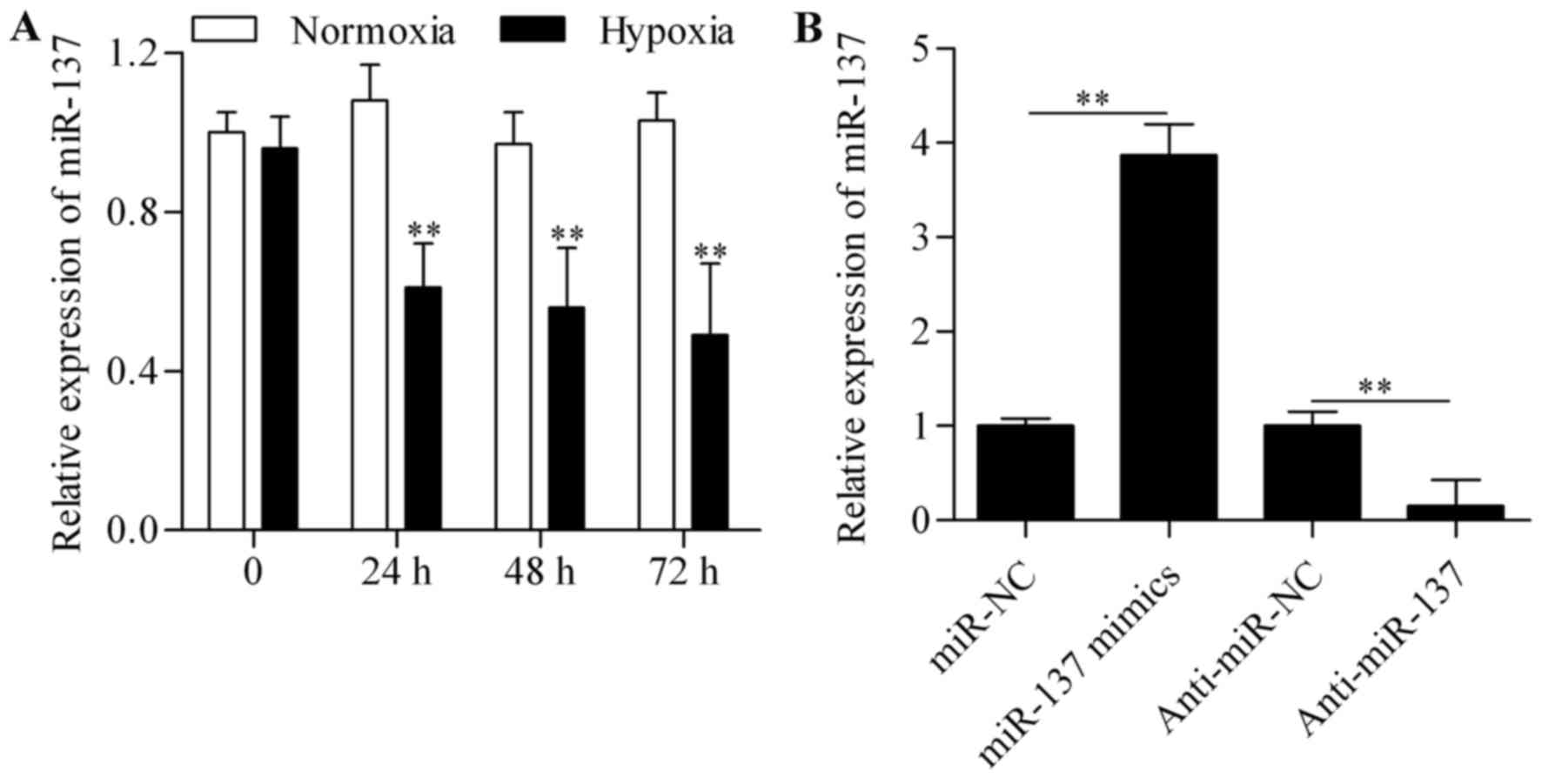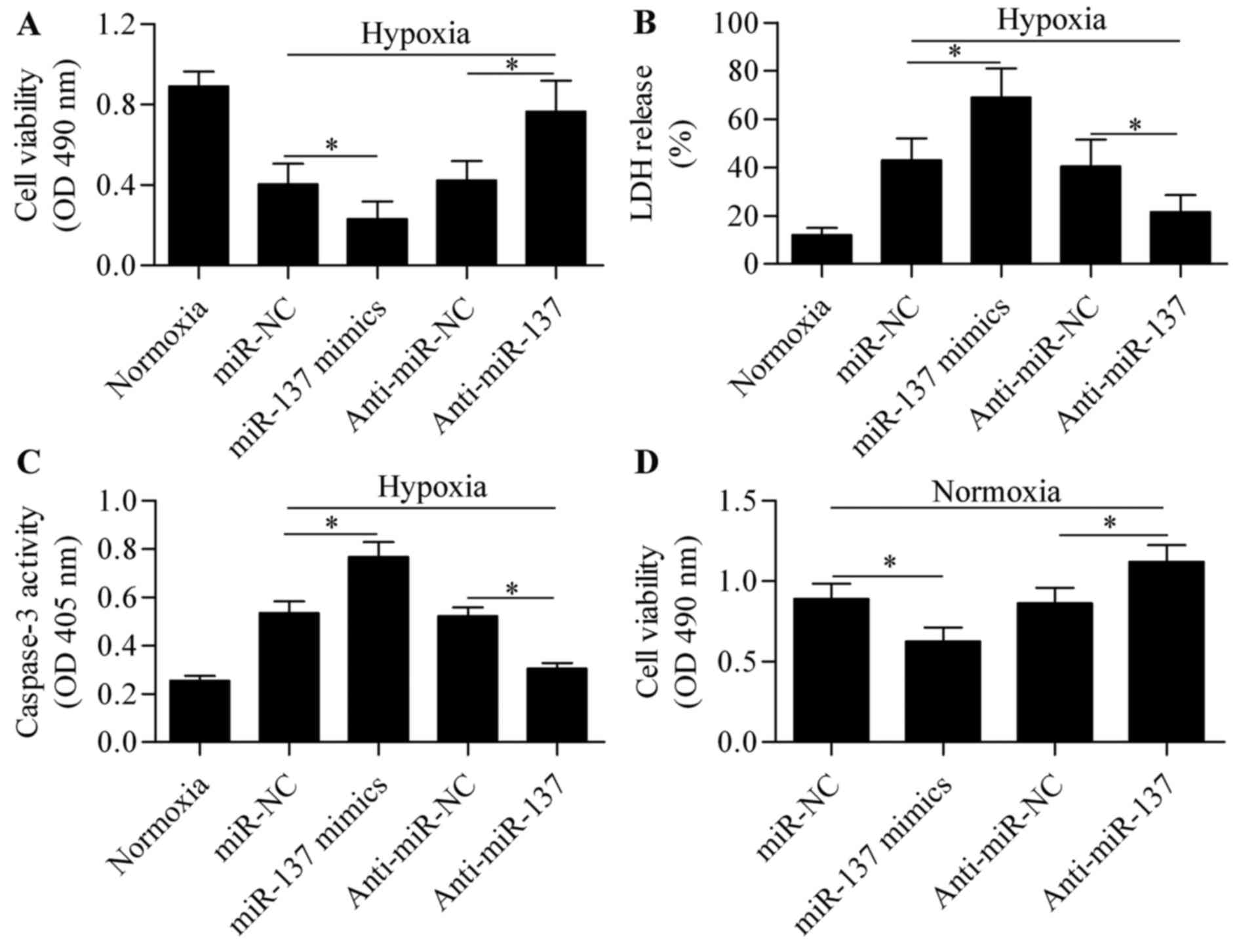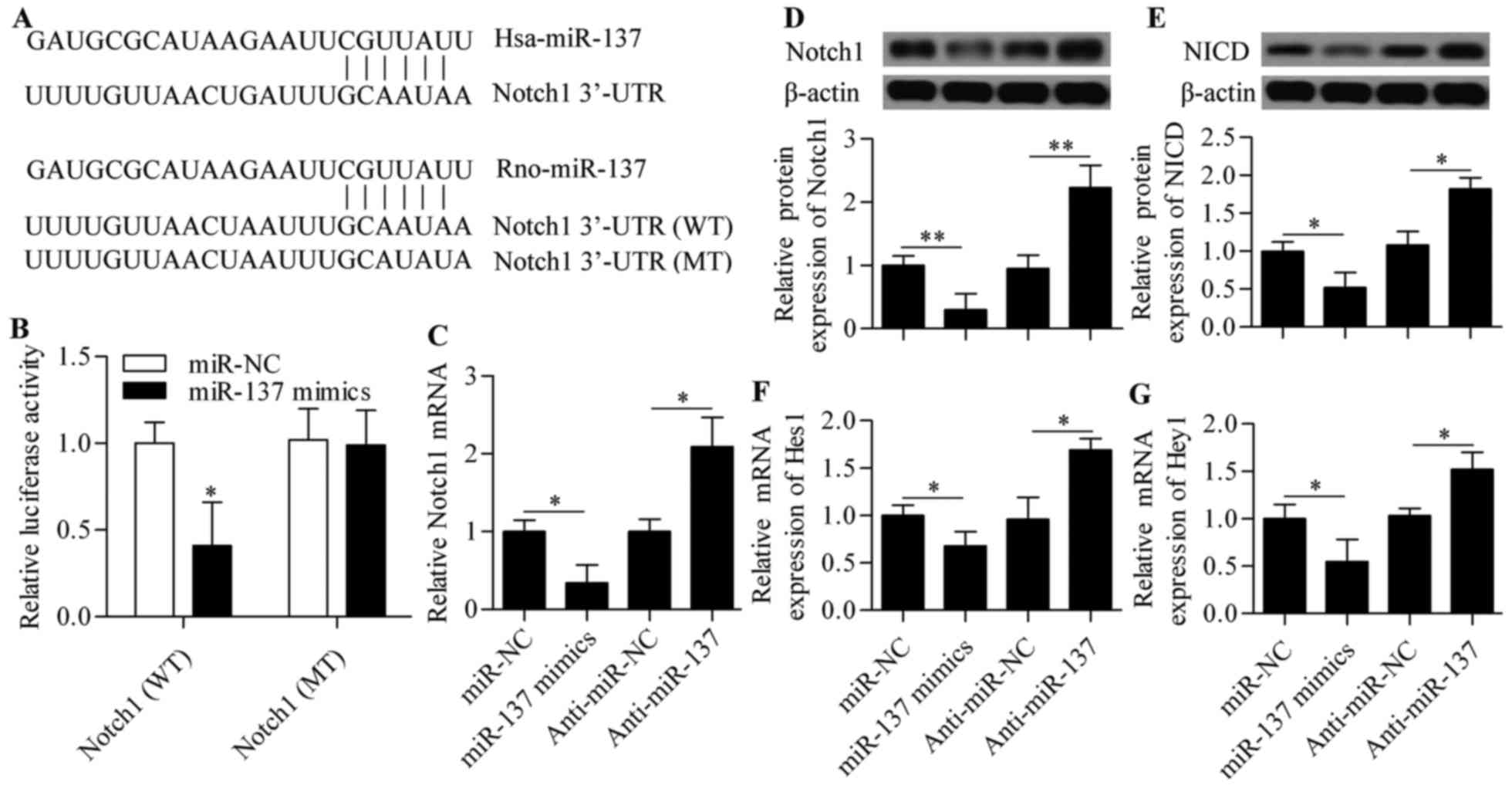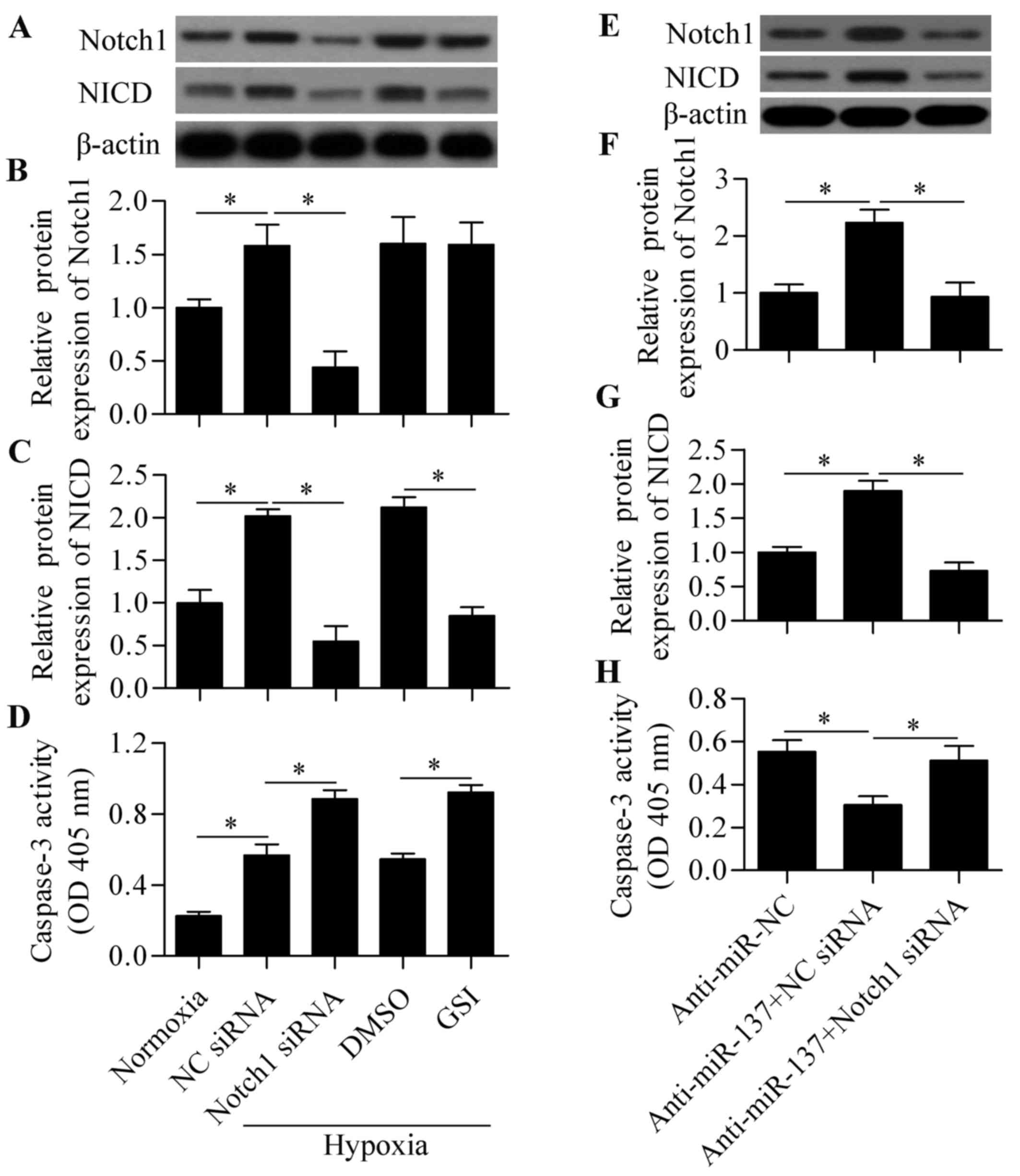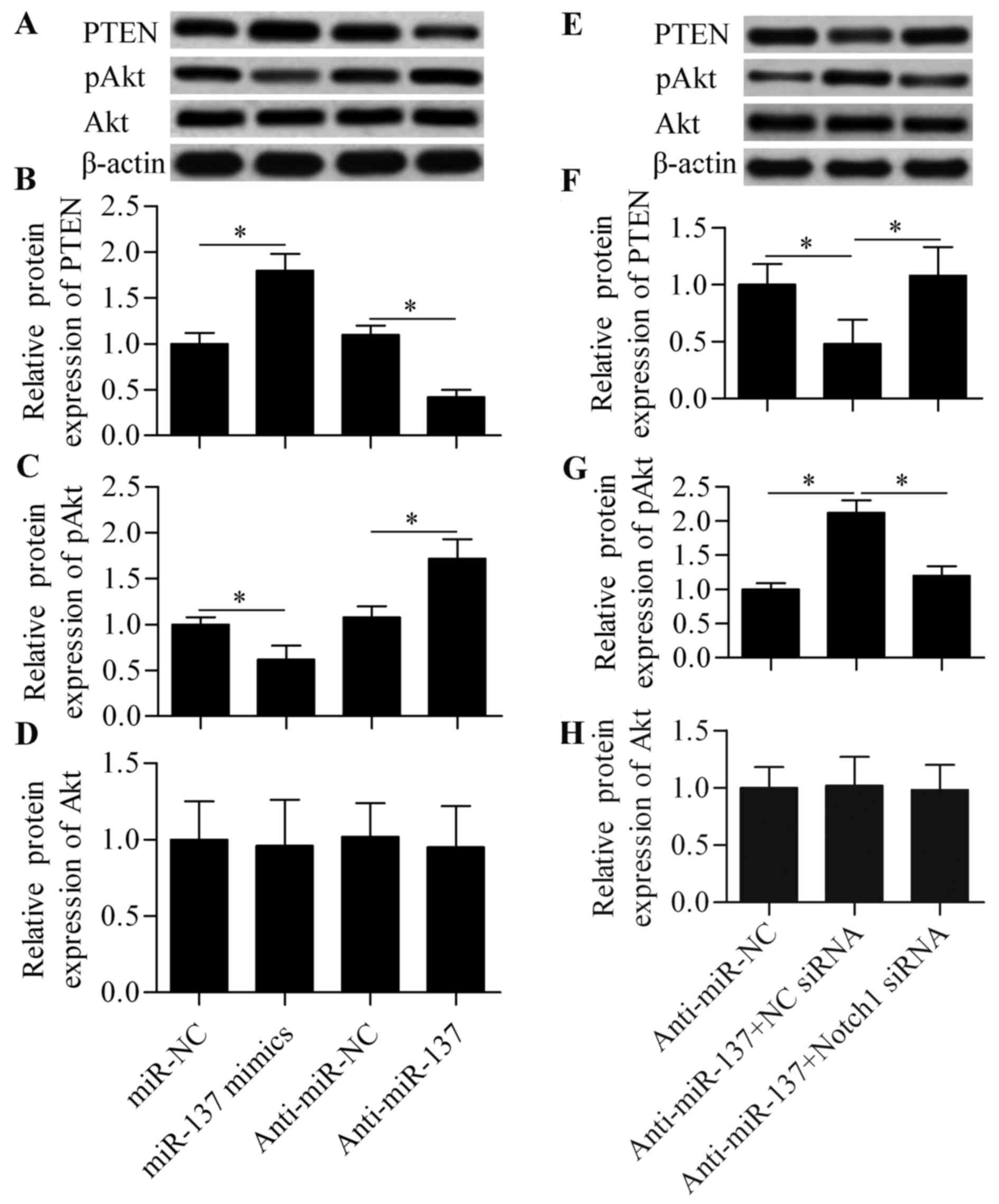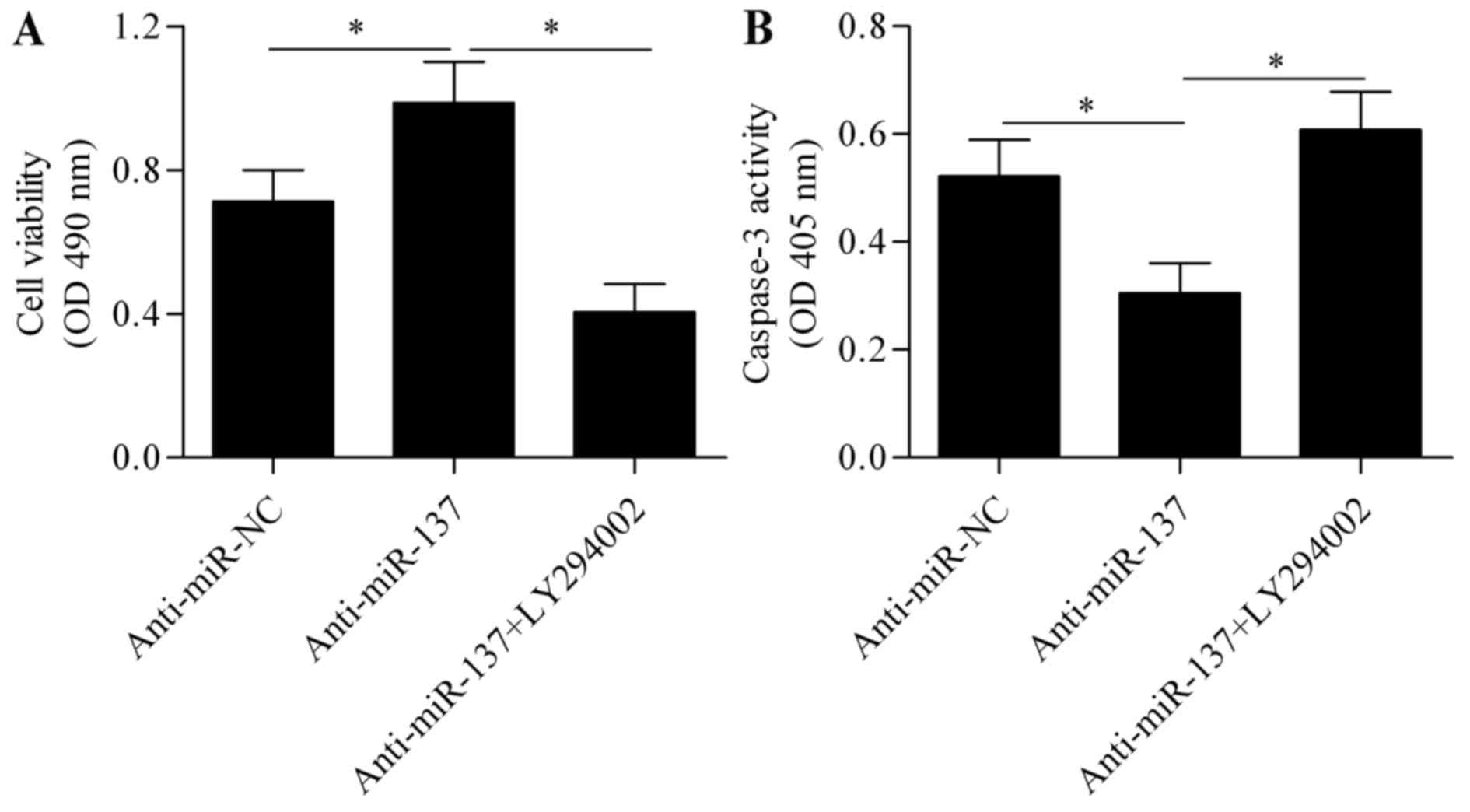MicroRNA-137 regulates hypoxia-induced retinal ganglion cell apoptosis through Notch1
- Authors:
- Published online on: December 12, 2017 https://doi.org/10.3892/ijmm.2017.3319
- Pages: 1774-1782
Abstract
Introduction
Retinal ganglion cells (RGCs) are important neurons in the retina that transmit visual signals from the retina to the brain (1,2). RGCs are particularly susceptible to acute, transient and mild systemic hypoxic stress that induces their apoptosis or necrosis (3). The loss of RGCs in a number of ocular pathologies, such as retinal detachment, leads to irreversible visual injury (1,2). Hypoxia is the critical pathological factor for several optic neuropathies, and hypoxia-induced apoptosis of RGCs results in progressive vision loss (4–6). Detachment of the retina causes retinal ischemia/reperfusion and hypoxia, resulting in apoptosis of RGCs (7), which is irreversible; thus, protecting RGCs against hypoxia-evoked cell apoptosis is crucial for treating hypoxia-induced retinal diseases.
The Notch signaling pathway plays an important role in various cellular processes, including cell proliferation and apoptosis, and is involved in numerous pathological processes (8,9). There are four Notch receptors (Notch1-4) and five Notch ligands, including Jagged1, Jagged2, Delta-like 1 (Dll1), Dll3 and Dll4 (10). The binding of Notch receptors and ligands results in cleavage of the Notch intracellular domain (NICD) that translocates into the nucleus to activate the transcription of Notch target genes, such as Hes1 and Hey1 (11,12). The Notch signaling pathway plays an important role in the development of the liver, kidney, eye, heart and skeleton (13). Notch signaling has been implicated in the regulation of an increasing number of stem cells in several different tissues (14). Aberrant activation of the Notch signaling pathway has been observed in various cancers (15). The Notch signaling pathway is extensively involved in regulating cell proliferation, apoptosis and differentiation through crosstalk with other signaling pathways (16). Recent studies indicated that Notch signaling participates in several hypoxia-induced pathological processes (17,18). Notch signaling has also been shown to protect the myocardium (19), liver (20) and cerebrum (21) from ischemia/reperfusion- and hypoxia-induced injury. However, the role of Notch signaling in hypoxia-induced cell apoptosis of RGCs has not been extensively investigated.
A group of small non-coding RNAs, referred to as microRNAs (miRNAs), have drawn significant attention over the past few decades, due to their negative regulatory effects on gene expression. miRNAs consist of ~22 nucleotides and suppress gene expression by targeting the 3′-untranslated region (3′-UTR), leading to translation inhibition (22–24). Thus, miRNAs are involved in the regulation of a wide range of cellular processes, such as stress response, cell survival and apoptosis (22). Several studies have demonstrated that targeting specific miRNAs may be a novel strategy for inhibiting apoptosis of RGCs (25–27). However, the precise mechanisms of miRNAs in regulating RGC apoptosis have not been fully elucidated.
miR-137 is a neuron-associated miR that is abundantly expressed in the brain and regulates neural differentiation and maturation (28–30). Recently, miR-137 was reported to be a hypoxia-responsive miRNA in mouse brain cells exposed to hypoxic conditions (31). However, whether miR-137 plays a role in RGCs exposed to hypoxia remains unknown. In the present study, the role of miR-137 and the involvement of Notch signaling in hypoxia-induced apoptosis of RGCs was investigated.
Materials and methods
Cell culture
The rat retinal ganglion cell line RGC-5 and human embryonic kidney 293 (HEK-293) cells were obtained from the American Type Culture Collection (Manassas, VA, USA) and were cultured in Dulbecco's modified Eagle's medium (DMEM) containing 10% fetal calf serum (both from Gibco-BRL; Thermo Fisher Scientific, Rockville, MD, USA) and 1/100 streptomycin/penicillin (Sigma-Aldrich; Merck KGaA, St. Louis, MO, USA). Cells were routinely maintained in a culture chamber containing 5% CO2 at 37°C.
Hypoxia treatment
Cells were cultured in a multi-gas incubator (Thermo Fisher Scientific, Shanghai, China) containing 5% O2, 90% N2 and 5% CO2, and incubated at 37°C. After washing twice with deoxygenated serum-free DMEM, cells from each treatment were incubated in the hypoxic incubator for 24, 48 and 72 h. Cells cultured under normoxic conditions were used as control.
Quantitative polymerase chain reaction (qPCR) analysis
Briefly, total RNA was extracted using the miRNeasy mini kit (Qiagen, Dusseldorf, Germany) according to the recommended protocols. cDNA was synthesized using M-MLV reverse transcriptase (BioTeke, Beijing, China) or miScript reverse transcription kit (Qiagen). qPCR was performed using SYBR-Green PCR Master Mix (for mRNA amplification) or TaqMan miRNA reverse transcription kit (for miRNA amplification) (Applied Biosystems, Carlsbad, CA, USA). The primers used were as follows: miR-137 forward, 5′-gcgcgcttattgcttaagaatac-3′ and reverse, 5′-gtgcagggtccgaggt-3; U6 snRNA forward, 5′-ctcgcttcggcagcaca-3′ and reverse, 5′-aacgcttcacgaatttgcgt-3′; Notch1 forward, 5′-atgactgcccaggaaacaac-3′ and reverse, 5′-gtccagccattgacacacac-3′; Hes-1 forward, 5′-agccaactgaaaacacctgatt-3′ and reverse, 5′-ggactttatgattagcagtgg-3′; Hey1 forward, 5′-ccgcttcgtgttcgcctggt-3′ and reverse, 5′-tgctgcctgtgagggtgtcg-3′; and β-actin forward, 5′-gtggggcgccccaggcacca-3′ and reverse, 5′-cttccttaatgtcacgcacgatttc-3′. β-actin (for mRNA) and U6 snRNA (for miRNA) were used as internal control genes. Relative gene expression was calculated using the 2−ΔΔCq method (32).
Cell transfection
The miR-137 mimics (5′-uuauugcuuaagaauacgcguagtt-3′), miR-137 inhibitor (anti-miR-137, 5′-cuacgcguauucuuaagcaauaa-3′ with 2′-O-methyl modification) and their negative controls (miR-NC or anti-miR-NC) were synthesized by GenePharma (Shanghai, China). The miRNAs and Notch1 siRNA (Santa Cruz Biotechnology, Inc., Santa Cruz, CA, USA) were transfected into cells using Lipofectamine 2000 reagent (Invitrogen, Carlsbad, CA, USA) according to the manufacture's instruction. The transfections were incubated for 24 h and then subjected to hypoxic conditions for another 24 h.
Cell viability
The 3-(4,5-dimethyl-thiazol-2-yl)-2,5-diphenyltetrazolium bromide (MTT) and lactate dehydrogenase (LDH) assays were used to assess cell viability. For the MTT assay, cells were seeded into 96-well plates (5×103 cells/well) overnight. Thereafter, the cells were transfected with miR-137 mimics, anti-miR-137 or Notch1 siRNA for 24 h under normoxic conditions, followed by 24 h under hypoxic conditions. Following incubation, 20 µl of MTT stock solution (Sigma-Aldrich; Merck KGaA) were added to each well and incubated for 4 h. The medium was discarded and the formazan crystals were dissolved by addition of dimethyl sulfoxide (200 µl/well; Sigma-Aldrich; Merck KGaA). After gently shaking for 15 min, the optical density (OD) value at 490 nm was measured using a microplate reader (Bio-Tek Instruments; Winooski, VT, USA). The LDH assay was performed using a cytotoxicity LDH assay kit (BioVision, Milpitas, CA, USA). Briefly, cells were seeded into 96-well plates with treatments as described above. Subsequently, 0.2% Triton X-100 was added to lyse the cells, followed by centrifugation at 250 × g for 2 min at 4°C. A total of 100 µl of the supernatant from each well were added to a new 96-well plate; then, 100 µl of working solution was added to each well and incubated for 30 min in the dark. The reaction was stopped by adding 50 µl of stop solution. The OD value at 490 nm was determined using a microplate reader. The lysis ratio was calculated as follows: (Experimental release-spontaneous release)/(maximum release-spontaneous release) ×100%.
Apoptosis assay
Cell apoptosis was detected with the caspase-3 activity assay using a commercial kit (BioVision). Briefly, after treatment, cells were harvested, lysed in ice-cold cell lysis buffer and centrifuged at 10,000 × g for 1 min. Protein concentration was measured in the resultant supernatant. Subsequently, 50 µl of cell lysis buffer was added to 100 µg protein and incubated with 50 µl of reaction buffer and 5 µl of 4 mM DEVD-pNA substrate at 37°C for 2 h. The OD value at 405 nm was determined using a microplate reader.
Western blot analysis
Proteins were extracted from the cells using a protein extraction kit (Applygen Technologies, Beijing, China). The protein concentration was measured using the Bio-Rad Protein Assay kit (Bio-Rad, Hercules, CA, USA). A total of 25 µg proteins from different groups were separated by 12.5% sodium dodecyl sulfate-polyacrylamide gel electrophoresis. The proteins were then transferred to a polyvinylidene difluoride (PVDF) membrane (Millipore, Temecula, CA, USA). The membranes were then blocked by 3% non-fat milk at 37°C for 1 h. The membranes were incubated at 4°C overnight with primary antibodies. The membranes were washed thrice with TBST and then incubated with goat anti-rabbit horseradish peroxidase-labeled secondary antibodies (sc-2004; 1:5,000; Santa Cruz Biotechnology, Inc.) at 37°C for 1 h. The bands were visualized using an enhanced chemiluminescence kit (Pierce, Rockford, IL, USA) and intensity was quantitatively analyzed using Image-Pro Plus 6.0 software (Media Cybernetics, Rockville, MD, USA). Rabbit polyclonal primary antibodies including anti-Notch1 (sc-9170; 1:200) anti-PTEN (sc-9145; 1:250), anti-Akt (sc-8312; 1:500), anti-pAkt (sc-135650; 1:200) and anti-β-actin (sc-7210; 1:500) were purchased from Santa Cruz Biotechnology, Inc. Rabbit monoclonal anti-NICD (no. 3608; 1:1,000) was purchased from Cell Signaling Technology (Danvers, MA, USA).
Dual-luciferase reporter assay
The 3′-UTR of Notch1, containing the miR-137 binding site, was amplified and then cloned into pmirGLO Dual-Luciferase miRNA Target Expression Vectors (Promega, Madison, WI, USA). For reporter assays, cells were seeded into 24-well plates and co-transfected with miR-137 mimics and pmirGLO-Notch1 3′-UTR constructs using Lipofectamine 2000 (Invitrogen; Thermo Fisher Scientific). After a 48-h incubation, cells were lysed and firefly and Renilla luciferase activity was detected using the Dual-Luciferase Assay system (Promega).
Statistical analysis
Quantitative data are presented as mean ± standard deviation. Statistical analyses were performed by Student's t-test or one-way analysis of variance using SPSS software, version 11.5 (SPSS, Inc., Chicago, IL, USA). A P-value <0.05 was defined as statistically significant.
Results
miR-137 affects the survival of RGC-5 cells exposed to hypoxic conditions
To investigate whether miR-137 is a hypoxia-responsive miRNA in RGC-5 cells, the expression levels of miR-137 were measured by qPCR. The results revealed that the expression of miR-137 was significantly suppressed in RGC-5 cells subjected to hypoxic conditions (Fig. 1A), indicating that miR-137 may play a role in RGC-5 cells following hypoxia. To further investigate this role, gain- and loss-of-function experiments were performed. RGC-5 cells were transfected with miR-137 mimics or anti-miR-137 to overexpress or silence miR-137, respectively. On qPCR analysis, miR-137 expression was found to be markedly increased in cells transfected with miR-137 mimics and significantly decreased by anti-miR-137 transfection (Fig. 1B). The effect of miR-137 overexpression or silencing on hypoxia-induced cell injury was next analyzed. Results from the MTT and LDH assays revealed that miR-137 overexpression significantly aggravated hypoxia-induced cell injury, whereas suppression of miR-137 markedly reversed the inhibitory effect of hypoxia on cell viability (Fig. 2A and B). To verify the role of miR-137 in RGC-5 cell survival following hypoxia, hypoxia-induced apoptosis was analyzed using a caspase-3 assay. RGC-5 cells subjected to hypoxia exhibited higher level of caspase-3 activity, indicating hypoxia-induced cell apoptosis (Fig. 2C). As expected, the caspase-3 activity was further upregulated by miR-137 overexpression, but was significantly downregulated by miR-137 silencing (Fig. 2C). In addition, the role of miR-137 on cell viability of RGCs was further examined under normal conditions. The results demonstrated that miR-137 overexpression significantly inhibited cell viability, while miR-137 suppression promoted viability of RGCs (Fig. 2D). These results suggest that suppression of miR-137 is conducive to sustaining viability of RGC-5 cells under hypoxic conditions.
Notch1 is a direct target of miR-137
To elucidate the molecular mechanism of miR-137 in regulating RGC-5 cell survival, bioinformatics analyses were conducted to identify genes that contain putative target sites in their 3′-UTR sequences. Interestingly, Notch1 was found to be a potential target of miR-137 and the binding sites were conserved from human to rats (Fig. 3A). To validate this prediction, the direct interaction between miR-137 and Notch1 3′-UTR was examined using a dual-luciferase reporter assay. The results revealed that miR-137 mimics significantly decreased the luciferase activity of the pmirGLO reporter vector containing the wild-type 3′-UTR of Notch1 (WT) (Fig. 3B). This inhibitory effect was not observed in the pmirGLO reporter vector carrying Notch1 with mutated 3′-UTR target sites (MT) (Fig. 3B), confirming the specificity of miR-137 for Notch.
The effects of miR-137 on the Notch signaling pathway were detected by qPCR and western blot analysis. Overexpression of miR-137 resulted in a significant decrease of Notch1 mRNA and protein expression, whereas anti-miR-137 transfection caused a marked increase of Notch1 mRNA and protein expression (Fig. 3C and D). Subsequently, the expression levels of NICD, Hes1 and Hey1 were also affected, in that the protein expression of NICD and the mRNA expression of Hes1 and Hey1 were significantly decreased by miR-137 overexpression and increased by miR-137 inhibition (Fig. 3E–G). These results indicate that miR-137 regulates the Notch signaling pathway by targeting Notch1.
miR-137 regulates hypoxia-induced apoptosis through Notch1
To verify whether the Notch1-mediated signaling pathway was involved in response to hypoxia in RGC-5 cells, the effect of blocking Notch signaling on cell survival under hypoxia was investigated. Compared with normoxia, hypoxic conditions significantly induced the expression of Notch1 and NICD expression (Fig. 4A–C), indicating that hypoxia activated Notch signaling in RGC-5 cells. Next, Notch signaling was blocked by Notch1 siRNA or γ-secretase inhibitors (GSI) to investigate the role of Notch signaling in hypoxia-induced cell apoptosis. The results revealed that both Notch siRNA and GSI treatment significantly decreased the expression of NICD, indicating a suppressive effect on Notch signaling (Fig. 4A–C). We also demonstrated that blocking Notch signaling significantly aggravated cell apoptosis induced by hypoxia (Fig. 4D). These results indicated that the Notch signaling pathway plays an important role in regulating RGC-5 cell survival in response to hypoxia. To investigate whether miR-137 acts through Notch1, the effect of Notch1 siRNA on anti-miR-137-mediated cell survival was determined. The results demonstrated that knockdown of Notch1 significantly reversed the protective effect of anti-miR-137 on hypoxia-induced cell apoptosis (Fig. 4E–H). Taken together, these results indicate that miR-137 regulates hypoxia-induced apoptosis in RGC-5 cells through Notch1.
PTEN/Akt survival signaling is involved in miR-137-mediated Notch signaling
To further investigate the molecular mechanism by which miR-137 regulates cell survival in response to hypoxia, the effect of miR-137 on PTEN/Akt survival signaling was analyzed. Our results demonstrated that miR-137 overexpression significantly increased the expression of PTEN and decreased the expression of pAkt, whereas anti-miR-137 exerted the opposite effects (Fig. 5A–C). Moreover, the effect of anti-miR-137 was significantly blocked by Notch1 siRNA (Fig. 5E–G). Conversely, these treatments exerted no obvious effect on total Akt expression (Fig. 5D and H). Based on these results, it may be concluded that miR-137 regulates PTEN/Akt survival signaling through Notch1-mediated signaling. Downregulation of miR-137 increases Noth1 expression and activates the expression of Hes1, a negative regulator of PTEN. Then, Hes1 binds to the PTEN promoter and inhibits PTEN expression (33), thus leading to the upregulation of pAkt. To further verify that Akt signaling is involved in the mechanism underlying miR-137 regulation of hypoxia-induced apoptosis, Akt signaling was blocked using the specific inhibitor LY294002 (Beyotime Institute of Biotechnology, Haimen, China), followed by assessment of the effect of anti-miR-137 on cell apoptosis. The results revealed that the protective effect of anti-miR-137 on hypoxia-induced cell injury was significantly abrogated by blocking Akt signaling (Fig. 6A and B). Taken together, these results indicate that PTEN/Akt survival signaling is involved in miR-137-mediated Notch signaling.
Discussion
The present study demonstrated that miR-137 is significantly decreased in RGCs under hypoxic conditions, suggesting that miR-137 is a hypoxia-responsive miR. The downregulation of miR-137 may protect RGCs against hypoxia-induced apoptosis, whereas overexpression of miR-137 may aggravate cell apoptosis. These results suggest that miR-137 may serve as a potential target for inhibiting RGC apoptosis. Notch1 was identified as a novel target gene of miR-137. The underlying mechanism was associated with Notch signaling, which was shown to participate in hypoxia-induced cell apoptosis. These data indicate that miR-137 may serve as a promising molecular target for the treatment of optic neuropathy.
Various studies have demonstrated that miR-137 induces cell apoptosis and inhibits cell proliferation in a number of cancer cells (34–36). The overexpression of miR-137 significantly improves the inhibition rate and apoptosis rate in multiple myeloma cells treated with dexamethasone (37). Downregulation of miR-137 inhibits oxidative stress-induced cardiomyocyte apoptosis (38). Similarly, downregulation of miR-137 may protect cells against hypoxia-induced apoptosis (31). These findings suggest that miR-137 is a positive regulator of cell apoptosis and may function as a critical regulator in various pathological processes. The role of miR-137 in neurons has been widely investigated. miR-137 is expressed in the brain and regulates neural stem cell proliferation and differentiation (28), as well as neuronal maturation (30). Downregulation of miR-137 has also been found in Alzheimer's disease (39). However, whether miR-137 is involved in regulating RGC apoptosis is currently unknown. We herein demonstrated that miR-137 was downregulated in RGCs under hypoxic conditions, and suppression of miR-137 was able to protect RGCs against hypoxia-induced apoptosis. Our results further support the hypothesis that miR-137 is a hypoxia-responsive miR. Li et al (31) demonstrated that the downregulation of miR-137 under hypoxic conditions increased the expression of mitophagy receptors FUNDC1 and NIX, protecting cells from hypoxia-induced apoptosis by activating mitophagy (31). Therefore, the downregulation of miR-137 in response to hypoxia may be a self-protective mechanism of cells adapting to these conditions.
It was recently suggested that the Notch signaling pathway is important in the response to extracellular stress, particularly ischemic or hypoxic stresses. Yu and Song (40) reported that Notch1 signaling suppressed hypoxia-induced cardiomyocyte apoptosis by inhibiting the cell apoptosis pathway. Pei et al (41) demonstrated that Notch1 signaling protected cardiomyocytes against ischemia/reperfusion injury by reducing oxidative/nitrative stress. Ischemic preconditioning and postconditioning activates Notch signaling, promoting cardioprotection (42,43). Certain drugs, such as relaxin and TNF-α inhibitor, protect cardiomyocytes from ischemic or hypoxic damage by activating Notch signaling (44,45). Electroacupuncture pretreatment and isoflurane preconditioning attenuated cerebral ischemia-reperfusion injury through activation of the Notch signaling pathway (21,46). Furthermore, Notch signaling is also involved in hepatic and intestinal ischemia/reperfusion (20,47). Overall, these findings indicated that Notch signaling activation was protective for cells against ischemic or hypoxic conditions; however, the role of Notch signaling in RGCs exposed to hypoxia remained unknown. In the present study, we demonstrated that Notch signaling was activated in response to hypoxia in RGCs and that blocking Notch signaling with Notch1 siRNA or Notch inhibitor significantly aggravated cell apoptosis induced by hypoxia. These findings confirm a prosurvival signaling role for Notch in response to extracellular insults.
Of note, Notch1 has been found to be the target gene of miR-137. Luciferase reporter assays demonstrated that miR-137 directly targets the 3′-UTR of Notch1. Overexpression of miR-137 inhibits Notch1 expression, whereas suppression of miR-137 increases expression and activates Notch signaling. Therefore, we hypothesized that the downregulation of miR-137 by hypoxia may contribute to activation of Notch signaling to protect cells. Our data demonstrated that knockdown of Notch1 significantly blocked the protective effect of anti-miR-137, suggesting that miR-137 acted through targeting Notch1. Therefore, targeting miR-137 is a feasible method for modulating Notch signaling. Regulation of Notch signaling by miRNAs is becoming more widely investigated. In fact, several miRNAs, including miR-34a/c (48–50), miR-139-5p (51) and miR-200b (52), have been reported to be capable of modulating Notch signaling by targeting Notch1. To the best of our knowledge, this study is the first to report a direct asociation between miR-137 and Notch signaling, providing a novel molecular target for modulating Notch signaling.
Akt signaling is another important prosurvival signaling pathway for survival in RGCs (53). In the present study, activation of Notch signaling by downregulation of miR-137 was found to inhibit the expression of PTEN, the suppressor of Akt signaling, and thus increased the protein expression of pAkt. It has been demonstrated that the target gene of Notch signaling, Hes1, may bind to the PTEN promoter and inhibit PTEN expression (33). The activation of Akt signaling may be a major mechanism through which Notch signaling exerts prosurvival effect. In agreement with our findings, a recent study reported that miR-137 inhibited the phosphorylation of AKT and promoted cell apoptosis in response to dexamethasone in multiple myeloma cells (37). In addition, Cheng et al revealed that miR-137 functioned as a tumor suppressor through targeting cyclooxygenase-2, which subsequently suppressed the activation of the Akt signaling pathway in gastric cancer cells in vitro and in vivo (54). In the present study, we found that miR-137 regulated the Akt signaling pathway through modulating Notch1. Of note, Li et al demonstrated that miR-137 regulated cell apoptosis through regulation of FUNDC1 and NIX-mediated mitophagy (31). However, all these findings support the hypothesis that miR-137 is an important regulator of cell apoptosis. However, miR-137 may have diverse function targets in different cell types in response to different stimuli.
The role of miRNAs in regulating RGC apoptosis remains poorly understood. Kong et al reported that suppression of miR-100 protected RGCs against oxidative stress-induced apoptosis by targeting the insulin-like growth factor-1 receptor (IGF1R) (25). Upregulation of miR-96 reduces RGC apoptosis by targeting caspase-2 (55). Suppression of miR-134 was also found to protect RGCs against oxidative stress-induced apoptosis (26). Most recently, Kang et al (27) revealed that overexpression of miR-26a protected RGCs against oxidative stress-induced apoptosis by inhibiting PTEN and activating Akt signaling. These studies indicated that miRNAs may be novel tools for preventing RGC apoptosis. The present study demonstrated that miR-137 regulates RGC apoptosis in response to hypoxia through targeting Notch1 and Notch signaling, suggesting that a miR-137/Notch1 axis has the potential to be used as a molecular target for treatment of hypoxia-induced retinal diseases.
Glossary
Abbreviations
Abbreviations:
|
RGCs |
retinal ganglion cells |
|
miRNAs |
microRNAs |
|
NICD |
Notch intracellular domain |
|
3′-UTR |
3′-untranslated region |
|
GSI |
γ-secretase inhibitors |
Acknowledgments
The present study was supported by Hospital Fund Project 2010A-2.
References
|
Isenmann S, Kretz A and Cellerino A: Molecular determinants of retinal ganglion cell development, survival, and regeneration. Prog Retin Eye Res. 22:483–543. 2003. View Article : Google Scholar : PubMed/NCBI | |
|
Lo AC, Woo TT, Wong RL and Wong D: Apoptosis and other cell death mechanisms after retinal detachment: Implications for photoreceptor rescue. Ophthalmologica. 226(Suppl 1): 10–17. 2011. View Article : Google Scholar : PubMed/NCBI | |
|
Kergoat H, Hérard ME and Lemay M: RGC sensitivity to mild systemic hypoxia. Invest Ophthalmol Vis Sci. 47:5423–5427. 2006. View Article : Google Scholar : PubMed/NCBI | |
|
Osborne NN, Casson RJ, Wood JP, Chidlow G, Graham M and Melena J: Retinal ischemia: Mechanisms of damage and potential therapeutic strategies. Prog Retin Eye Res. 23:91–147. 2004. View Article : Google Scholar : PubMed/NCBI | |
|
Chen YN, Yamada H, Mao W, Matsuyama S, Aihara M and Araie M: Hypoxia-induced retinal ganglion cell death and the neuroprotective effects of beta-adrenergic antagonists. Brain Res. 1148:28–37. 2007. View Article : Google Scholar : PubMed/NCBI | |
|
Kaur C, Foulds WS and Ling EA: Hypoxia-ischemia and retinal ganglion cell damage. Clin Ophthalmol. 2:879–889. 2008. View Article : Google Scholar | |
|
Garweg JG, Tappeiner C and Halberstadt M: Pathophysiology of proliferative vitreoretinopathy in retinal detachment. Surv Ophthalmol. 58:321–329. 2013. View Article : Google Scholar : PubMed/NCBI | |
|
Joutel A and Tournier-Lasserve E: Notch signalling pathway and human diseases. Semin Cell Dev Biol. 9:619–625. 1998. View Article : Google Scholar | |
|
Marignol L, Rivera-Figueroa K, Lynch T and Hollywood D: Hypoxia, notch signalling, and prostate cancer. Nat Rev Urol. 10:405–413. 2013. View Article : Google Scholar : PubMed/NCBI | |
|
Samon JB, Champhekar A, Minter LM, Telfer JC, Miele L, Fauq A, Das P, Golde TE and Osborne BA: Notch1 and TGFbeta1 cooperatively regulate Foxp3 expression and the maintenance of peripheral regulatory T cells. Blood. 112:1813–1821. 2008. View Article : Google Scholar : PubMed/NCBI | |
|
McCright B: Notch signaling in kidney development. Curr Opin Nephrol Hypertens. 12:5–10. 2003. View Article : Google Scholar | |
|
Hayward P, Kalmar T and Arias AM: Wnt/Notch signalling and information processing during development. Development. 135:411–424. 2008. View Article : Google Scholar : PubMed/NCBI | |
|
Fiúza UM and Arias AM: Cell and molecular biology of Notch. J Endocrinol. 194:459–474. 2007. View Article : Google Scholar : PubMed/NCBI | |
|
Liu J, Sato C, Cerletti M and Wagers A: Notch signaling in the regulation of stem cell self-renewal and differentiation. Curr Top Dev Biol. 92:367–409. 2010. View Article : Google Scholar : PubMed/NCBI | |
|
Yuan X, Wu H, Xu H, Xiong H, Chu Q, Yu S, Wu GS and Wu K: Notch signaling: An emerging therapeutic target for cancer treatment. Cancer Lett. 369:20–27. 2015. View Article : Google Scholar : PubMed/NCBI | |
|
Hurlbut GD, Kankel MW, Lake RJ and Artavanis-Tsakonas S: Crossing paths with Notch in the hyper-network. Curr Opin Cell Biol. 19:166–175. 2007. View Article : Google Scholar : PubMed/NCBI | |
|
Pear WS and Simon MC: Lasting longer without oxygen: The influence of hypoxia on Notch signaling. Cancer Cell. 8:435–437. 2005. View Article : Google Scholar : PubMed/NCBI | |
|
Al Haj Zen A and Madeddu P: Notch signalling in ischaemia-induced angiogenesis. Biochem Soc Trans. 37:1221–1227. 2009. View Article : Google Scholar : PubMed/NCBI | |
|
Yu L, Li F, Zhao G, Yang Y, Jin Z, Zhai M, Yu W, Zhao L, Chen W, Duan W, et al: Protective effect of berberine against myocardial ischemia reperfusion injury: Role of Notch1/Hes1-PTEN/Akt signaling. Apoptosis. 20:796–810. 2015. View Article : Google Scholar : PubMed/NCBI | |
|
Yu HC, Qin HY, He F, Wang L, Fu W, Liu D, Guo FC, Liang L, Dou KF and Han H: Canonical notch pathway protects hepatocytes from ischemia/reperfusion injury in mice by repressing reactive oxygen species production through JAK2/STAT3 signaling. Hepatology. 54:979–988. 2011. View Article : Google Scholar : PubMed/NCBI | |
|
Zhang HP, Sun YY, Chen XM, Yuan LB, Su BX, Ma R, Zhao RN, Dong HL and Xiong L: The neuroprotective effects of isoflurane preconditioning in a murine transient global cerebral ischemia-reperfusion model: The role of the Notch signaling pathway. Neuromolecular Med. 16:191–204. 2014. View Article : Google Scholar | |
|
Mendell JT and Olson EN: MicroRNAs in stress signaling and human disease. Cell. 148:1172–1187. 2012. View Article : Google Scholar : PubMed/NCBI | |
|
Bartel DP: MicroRNAs: Genomics, biogenesis, mechanism, and function. Cell. 116:281–297. 2004. View Article : Google Scholar : PubMed/NCBI | |
|
Winter J, Jung S, Keller S, Gregory RI and Diederichs S: Many roads to maturity: microRNA biogenesis pathways and their regulation. Nat Cell Biol. 11:228–234. 2009. View Article : Google Scholar : PubMed/NCBI | |
|
Kong N, Lu X and Li B: Downregulation of microRNA-100 protects apoptosis and promotes neuronal growth in retinal ganglion cells. BMC Mol Biol. 15:252014. View Article : Google Scholar : PubMed/NCBI | |
|
Shao Y, Yu Y, Zhou Q, Li C, Yang L and Pei CG: Inhibition of miR-134 protects against hydrogen peroxide-induced apoptosis in retinal ganglion cells. J Mol Neurosci. 56:461–471. 2015. View Article : Google Scholar : PubMed/NCBI | |
|
Kang Y, Jia P, Zhao H, Hu C and Yang X: MicroRNA-26a overexpression protects RGC-5 cells against H2O2-induced apoptosis. Biochem Biophys Res Commun. 460:164–169. 2015. View Article : Google Scholar : PubMed/NCBI | |
|
Sun G, Ye P, Murai K, Lang MF, Li S, Zhang H, Li W, Fu C, Yin J, Wang A, et al: miR-137 forms a regulatory loop with nuclear receptor TLX and LSD1 in neural stem cells. Nat Commun. 2:5292011. View Article : Google Scholar : PubMed/NCBI | |
|
Chen L, Wang X, Wang H, Li Y, Yan W, Han L, Zhang K, Zhang J, Wang Y, Feng Y, et al: miR-137 is frequently down-regulated in glioblastoma and is a negative regulator of Cox-2. Eur J Cancer. 48:3104–3111. 2012. View Article : Google Scholar : PubMed/NCBI | |
|
Smrt RD, Szulwach KE, Pfeiffer RL, Li X, Guo W, Pathania M, Teng ZQ, Luo Y, Peng J, Bordey A, et al: MicroRNA miR-137 regulates neuronal maturation by targeting ubiquitin ligase mind bomb-1. Stem Cells. 28:1060–1070. 2010. View Article : Google Scholar : PubMed/NCBI | |
|
Li W, Zhang X, Zhuang H, Chen HG, Chen Y, Tian W, Wu W, Li Y, Wang S, Zhang L, et al: MicroRNA-137 is a novel hypoxia-responsive microRNA that inhibits mitophagy via regulation of two mitophagy receptors FUNDC1 and NIX. J Biol Chem. 289:10691–10701. 2014. View Article : Google Scholar : PubMed/NCBI | |
|
Livak KJ and Schmittgen TD: Analysis of relative gene expression data using real-time quantitative PCR and the 2(−Delta Delta C(T)) method. Methods. 25:402–408. 2001. View Article : Google Scholar | |
|
Palomero T, Dominguez M and Ferrando AA: The role of the PTEN/AKT Pathway in NOTCH1-induced leukemia. Cell Cycle. 7:965–970. 2008. View Article : Google Scholar : PubMed/NCBI | |
|
Yang Y, Li F, Saha MN, Abdi J, Qiu L and Chang H: miR-137 and miR-197 Induce Apoptosis and Suppress Tumorigenicity by Targeting MCL-1 in Multiple Myeloma. Clin Cancer Res. 21:2399–2411. 2015. View Article : Google Scholar : PubMed/NCBI | |
|
Zheng X, Dong J, Gong T, Zhang Z, Wang Y, Li Y, Shang Y, Li K, Ren G, Feng B, et al: MicroRNA library-based functional screening identified miR-137 as a suppresser of gastric cancer cell proliferation. J Cancer Res Clin Oncol. 141:785–795. 2015. View Article : Google Scholar | |
|
Deng D, Xue L, Shao N, Qu H, Wang Q, Wang S, Xia X, Yang Y and Zhi F: miR-137 acts as a tumor suppressor in astrocytoma by targeting RASGRF1. Tumour Biol. 37:3331–3340. 2016. View Article : Google Scholar | |
|
Zhang B, Ma L, Wei J, Hu J, Zhao Z, Wang Y, Chen Y and Zhao F: miR-137 suppresses the phosphorylation of AKT and improves the dexamethasone sensitivity in multiple myeloma cells via targeting MITF. Curr Cancer Drug Targets. 16:12016. View Article : Google Scholar | |
|
Wang J, Xu R, Wu J and Li Z: MicroRNA-137 negatively regulates H2O2-induced cardiomyocyte apoptosis through CDC42. Med Sci Monit. 21:3498–3504. 2015. View Article : Google Scholar : PubMed/NCBI | |
|
Geekiyanage H and Chan C: MicroRNA-137/181c regulates serine palmitoyltransferase and in turn amyloid β, novel targets in sporadic Alzheimer's disease. J Neurosci. 31:14820–14830. 2011. View Article : Google Scholar : PubMed/NCBI | |
|
Yu B and Song B: Notch1 signalling inhibits cardiomyocyte apoptosis in ischaemic postconditioning. Heart Lung Circ. 23:152–158. 2014. View Article : Google Scholar | |
|
Pei H, Yu Q, Xue Q, Guo Y, Sun L, Hong Z, Han H, Gao E, Qu Y and Tao L: Notch1 cardioprotection in myocardial ischemia/reperfusion involves reduction of oxidative/nitrative stress. Basic Res Cardiol. 108:3732013. View Article : Google Scholar : PubMed/NCBI | |
|
Zhou XL, Wan L, Xu QR, Zhao Y and Liu JC: Notch signaling activation contributes to cardioprotection provided by ischemic preconditioning and postconditioning. J Transl Med. 11:2512013. View Article : Google Scholar : PubMed/NCBI | |
|
Zhou XL, Wan L and Liu JC: Activated Notch1 reduces myocardial ischemia reperfusion injury in vitro during ischemic postconditioning by crosstalk with the RISK signaling pathway. Chin Med J (Engl). 126:4545–4551. 2013. | |
|
Boccalini G, Sassoli C, Formigli L, Bani D and Nistri S: Relaxin protects cardiac muscle cells from hypoxia/reoxygenation injury: Involvement of the Notch-1 pathway. FASEB J. 29:239–249. 2015. View Article : Google Scholar | |
|
Pei H, Song X, Peng C, Tan Y, Li Y, Li X, Ma S, Wang Q, Huang R, Yang D, et al: TNF-α inhibitor protects against myocardial ischemia/reperfusion injury via Notch1-mediated suppression of oxidative/nitrative stress. Free Radic Biol Med. 82:114–121. 2015. View Article : Google Scholar : PubMed/NCBI | |
|
Zhao Y, Chen X, Ma L, Zuo Z, Zhu Z, Zhu X, Wang Q, He E, Xiong L, Pei J, et al: Electroacupuncture pretreatment induces tolerance against focal cerebral ischemia through activation of canonical Notch pathway. BMC Neurosci. 13:1112012. View Article : Google Scholar : PubMed/NCBI | |
|
Chen G, Zhang Z, Cheng Y, Xiao W, Qiu Y, Yu M, Sun L, Wang W, Du G, Gu Y, et al: The canonical Notch signaling was involved in the regulation of intestinal epithelial cells apoptosis after intestinal ischemia/reperfusion injury. Int J Mol Sci. 15:7883–7896. 2014. View Article : Google Scholar : PubMed/NCBI | |
|
Kang L, Mao J, Tao Y, Song B, Ma W, Lu Y, Zhao L, Li J, Yang B and Li L: MicroRNA-34a suppresses the breast cancer stem cell-like characteristics by downregulating Notch1 pathway. Cancer Sci. 106:700–708. 2015. View Article : Google Scholar : PubMed/NCBI | |
|
Park EY, Chang E, Lee EJ, Lee HW, Kang HG, Chun KH, Woo YM, Kong HK, Ko JY, Suzuki H, et al: Targeting of miR34a-NOTCH1 axis reduced breast cancer stemness and chemoresistance. Cancer Res. 74:7573–7582. 2014. View Article : Google Scholar : PubMed/NCBI | |
|
Liu XD, Zhang LY, Zhu TC, Zhang RF, Wang SL and Bao Y: Overexpression of miR-34c inhibits high glucose-induced apoptosis in podocytes by targeting Notch signaling pathways. Int J Clin Exp Pathol. 8:4525–4534. 2015.PubMed/NCBI | |
|
Zhang HD, Sun DW, Mao L, Zhang J, Jiang LH, Li J, Wu Y, Ji H, Chen W, Wang J, et al: MiR-139-5p inhibits the biological function of breast cancer cells by targeting Notch1 and mediates chemosensitivity to docetaxel. Biochem Biophys Res Commun. 465:702–713. 2015. View Article : Google Scholar : PubMed/NCBI | |
|
Yang X, Ni W and Lei K: miR-200b suppresses cell growth, migration and invasion by targeting Notch1 in nasopharyngeal carcinoma. Cell Physiol Biochem. 32:1288–1298. 2013. View Article : Google Scholar : PubMed/NCBI | |
|
Yang X, Wei A, Liu Y, He G, Zhou Z and Yu Z: IGF-1 protects retinal ganglion cells from hypoxia-induced apoptosis by activating the Erk-1/2 and Akt pathways. Mol Vis. 19:1901–1912. 2013.PubMed/NCBI | |
|
Cheng Y, Li Y, Liu D, Zhang R and Zhang J: miR-137 effects on gastric carcinogenesis are mediated by targeting Cox-2-activated PI3K/AKT signaling pathway. FEBS Lett. 588:3274–3281. 2014. View Article : Google Scholar : PubMed/NCBI | |
|
Wang S and Li K: MicroRNA-96 regulates RGC-5 cell growth through caspase-dependent apoptosis. Int J Clin Exp Med. 7:3694–3702. 2014.PubMed/NCBI |



